Turn your orthodontic website into a patient-driving machine with real audits, high-intent keywords, and local orthodontic SEO built for how patients find care in 2026.
5.0

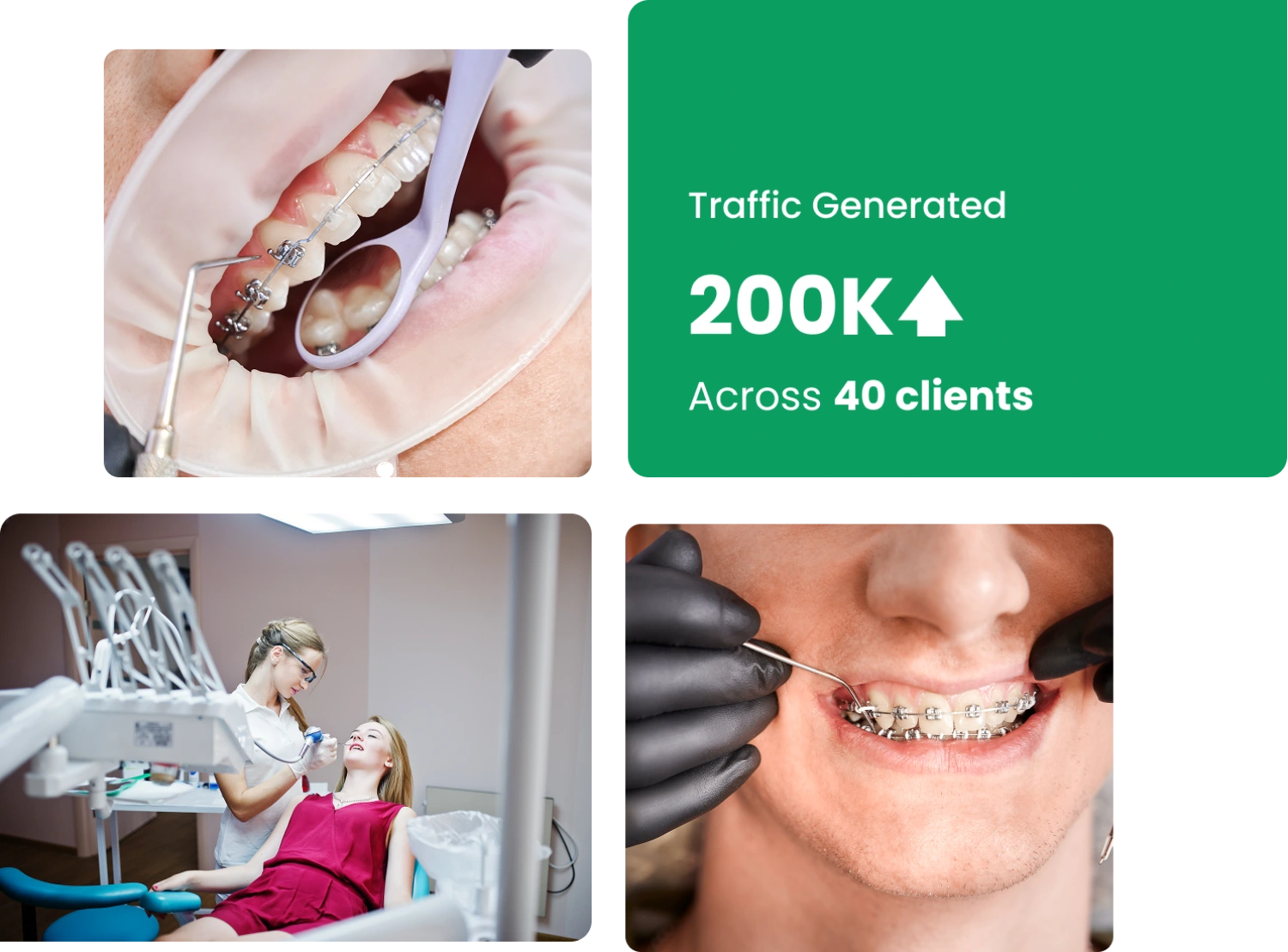

Orthodontists face real marketing challenges: bookings dip during school breaks or exams, and 125+ aligner brands compete for the same patients. Long treatment cycles slow conversions, and in cities, several clinics often share the same block.
Many people still picture only metal braces, missing clear or digital options. At the same time, clinics must appeal to both parents and patients themselves: teens or adults searching online.
That’s why orthodontic SEO has become essential for your industry. It helps clinics rank higher in local searches, reach the right audience, and convert awareness into steady appointments.
After working with 40+ orthodontists across the U.S., our SEO agency has refined a strategy that does exactly that, and we’ll break it down here.
Now that you know why SEO matters for orthodontists, let’s look at how to put it into action, starting with keyword research and competitive analysis.
Start by listing every service your clinic offers, both standard and niche.
Then, use tools like Ahrefs, SEMrush, or Google Keyword Planner to find what patients are searching for and which keywords competitors rank for.
Focus on high-search, low-competition terms. They bring quality traffic and faster rankings. But don’t skip broad terms like “orthodontist” or “orthodontic clinic” that build overall authority and visibility.
Example searches around braces: “best braces for teens,” “how much do braces cost,” “clear braces vs invisalign.” See more examples below:

Finally, research local keywords to identify high-demand areas or cities. This helps you target specific locations, or even plan mobile orthodontic services where patient interest is growing.
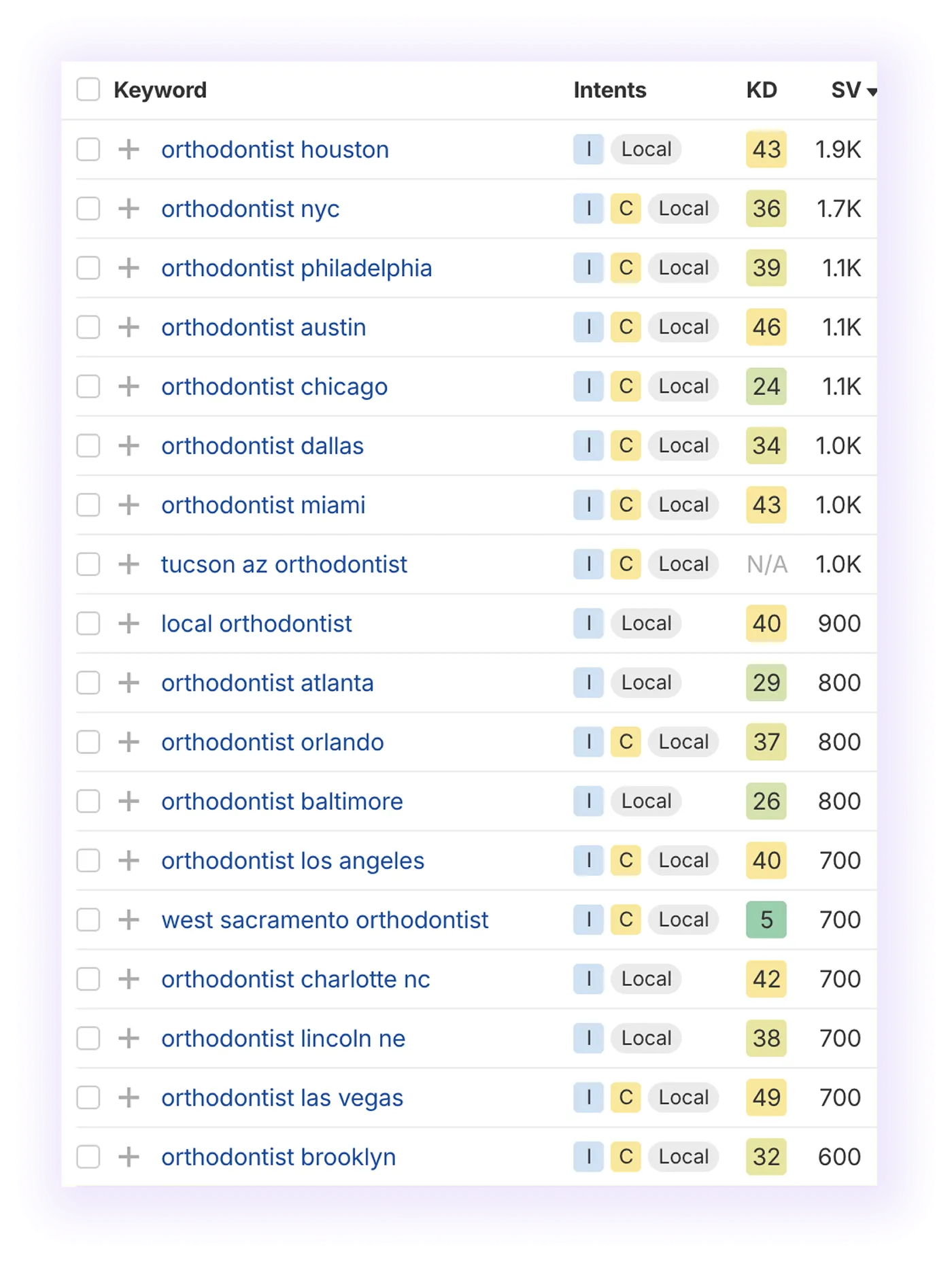
You can start adding these keywords to your site today, but using them strategically takes more than guesswork. To get the most from your SEO investment, reach out to our orthodontic SEO agency, and we’ll build a plan tailored to your clinic.
Once you’ve gathered your orthodontic keywords, covering services, braces, and Invisalign, you’ll need to map where each belongs on your site.
Start by defining your website hierarchy: which pages are main (parent) pages, and which are supporting (child) pages.
Every orthodontic website should include at least three core static pages:
Ensure these pages sit in your main navigation for easy user access and smooth crawling by Google.
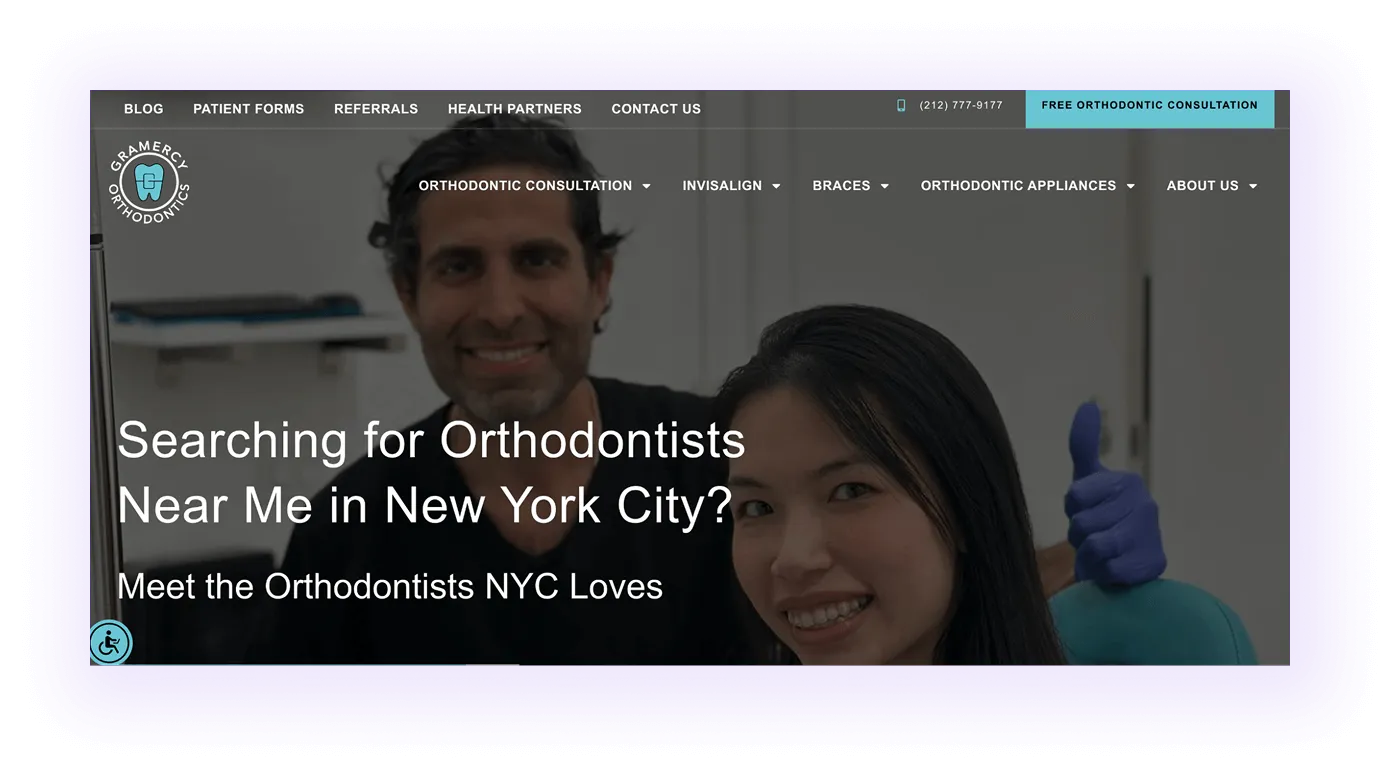
Each orthodontic service deserves its own page since patients often search for them individually. Common keyword examples include:
Add these pages to your main navigation menu. Use a dropdown or hover menu so visitors and search engines can quickly see all the services your clinic offers. The example below shows it.
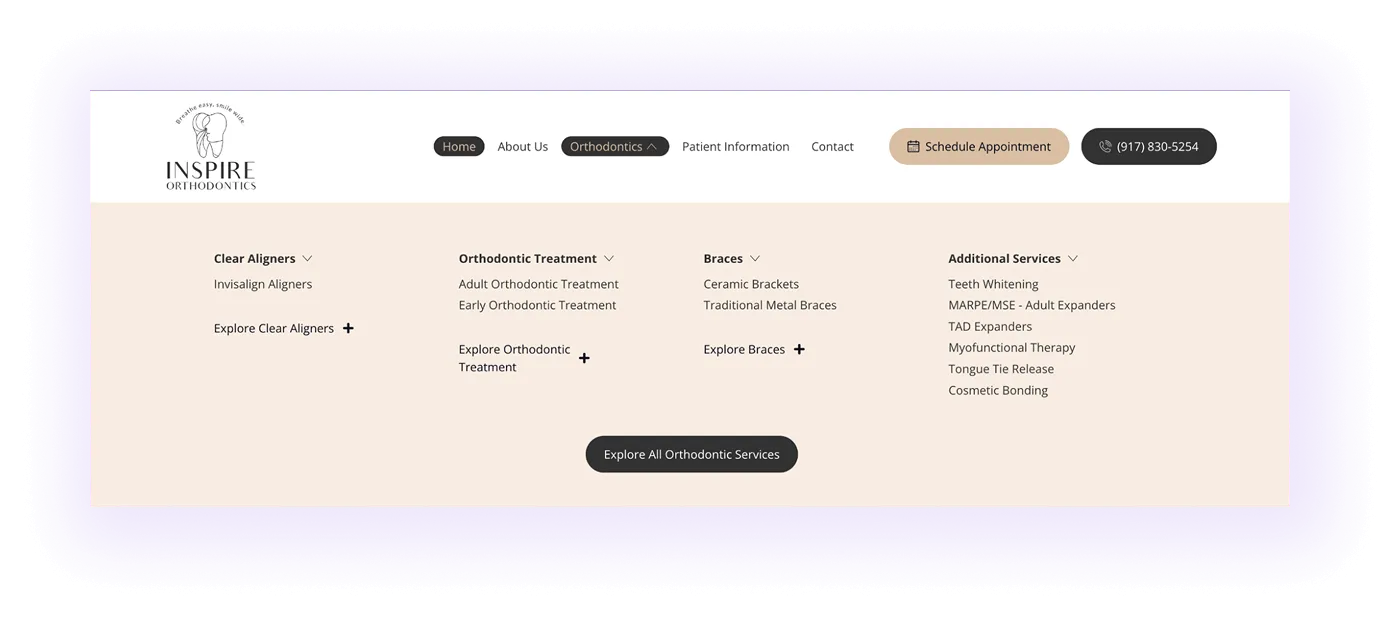
Because orthodontic care falls under Google’s Your Money, Your Life (YMYL) category, your site must clearly demonstrate expertise and trust. Many patients also search for orthodontists by name, so create individual pages for each doctor.
Each profile should include:
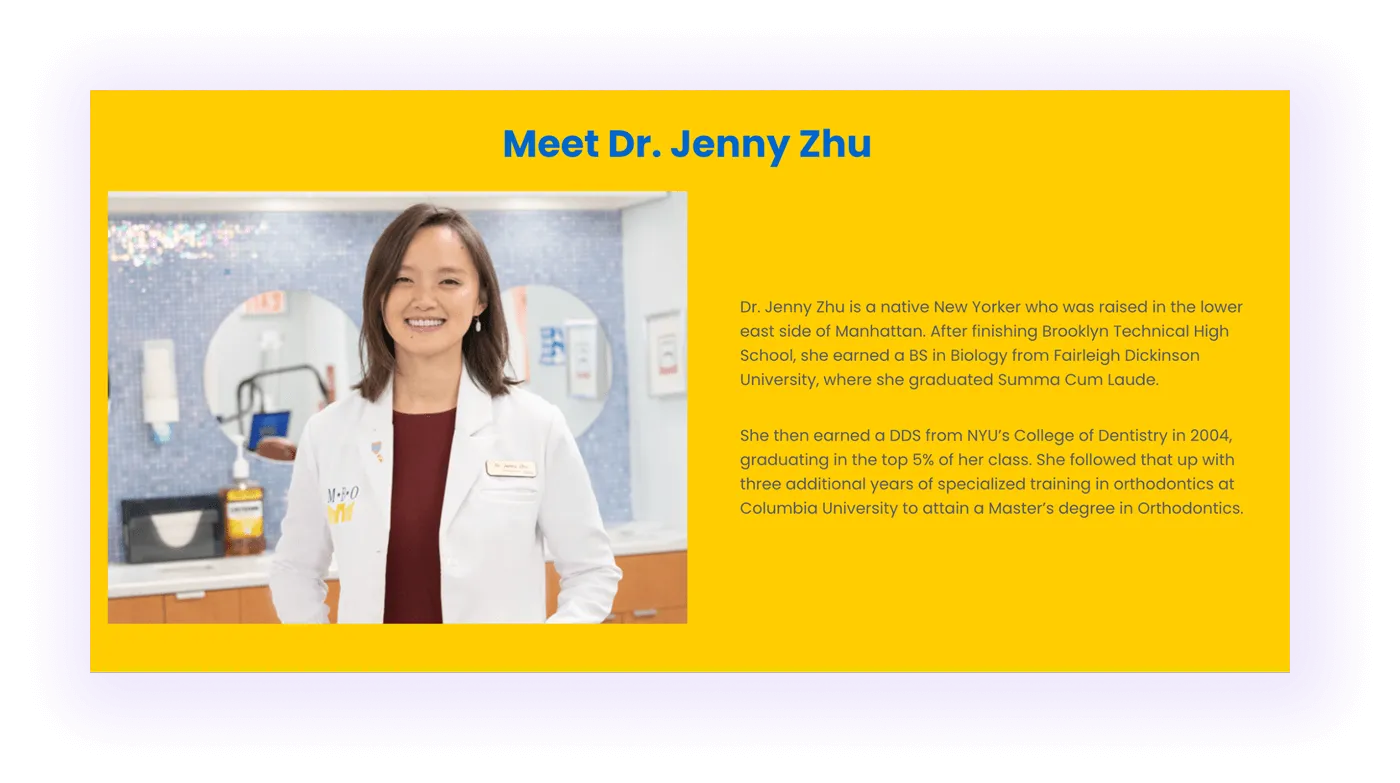
Feature your orthodontists in the main navigation menu or under an “Our doctors” section.
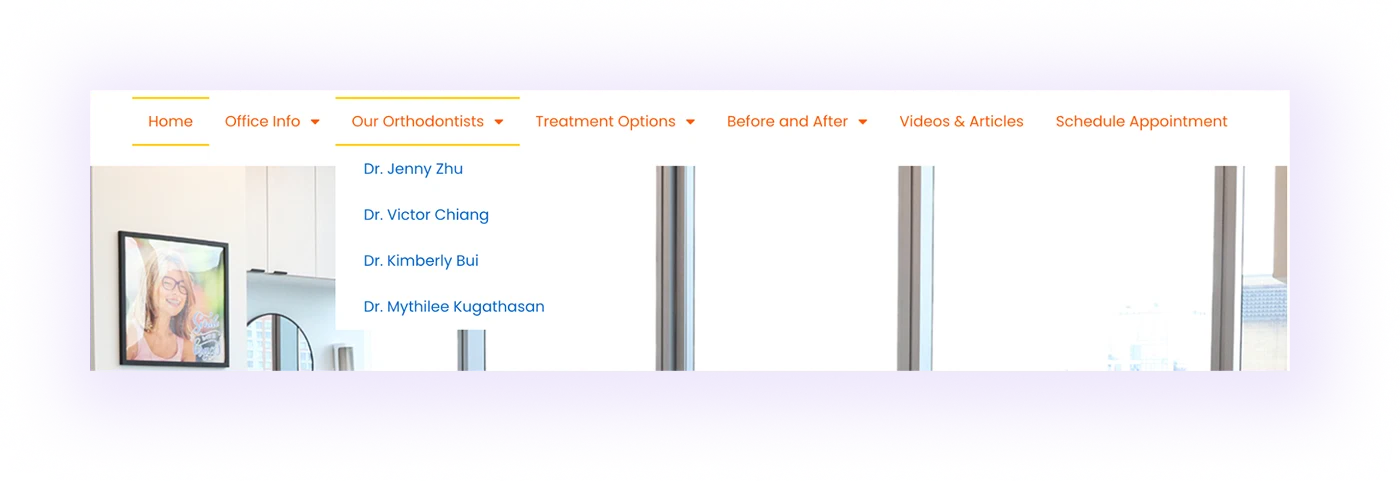
Parents usually look for nearby orthodontic care. They’ll search terms like “orthodontist houston,” “braces chicago,” “myofunctional therapy nyc,” or “invisalign specialist midtown ny.”
To capture those searches, build location-based pages targeting each area you serve. You can:

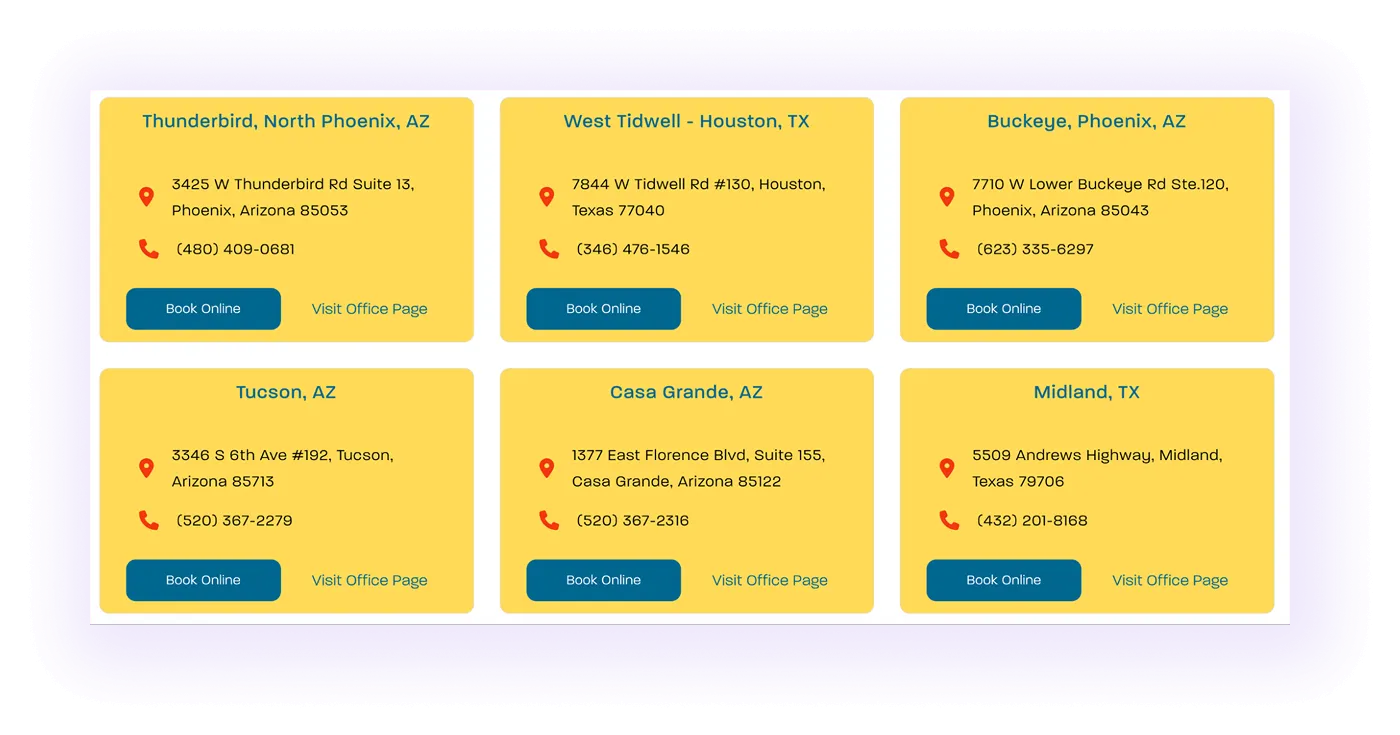
This approach helps your clinic rank for both service and location searches, so parents and patients nearby can find you faster.Blog PagesNot every parent or teen searching for orthodontic care is ready to book an appointment. Many start by researching questions like:A blog section helps you capture this research-stage traffic and introduce your clinic early in the decision process. Blog content should:
We’ll cover how to write and structure orthodontic blog posts later in this guide. For now, make sure your website includes a clear, accessible blog section in the main navigation.Stop Guessing Your Orthodontist Website Structure—We Will Show You Exactly What Pages You NeedYour orthodontic practice deserves more than a basic website structure. Contact us and let’s create a seamless user experience with SEO for orthodontists that ensures your website ranks well and converts visitors into loyal patients.How to Do Local SEO Marketing for OrthodontistsYour local SEO for orthodontists depends on your clinic type: single location, multi-location, or national practice. Here’s how to tailor your strategy for each.Local OrthodontistsIf your orthodontic clinic serves only one city, say LA, optimize every page with local keywords. Use phrases like:
For service pages, pair each treatment with the city name:
Be sure your meta titles, descriptions, and headings include both your service and location to strengthen local SEO visibility.
This approach helps your clinic rank for both service and location searches, so parents and patients nearby can find you faster.
Not every parent or teen searching for orthodontic care is ready to book an appointment. Many start by researching questions like:
A blog section helps you capture this research-stage traffic and introduce your clinic early in the decision process. Blog content should:
We’ll cover how to write and structure orthodontic blog posts later in this guide. For now, make sure your website includes a clear, accessible blog section in the main navigation.
Stop Guessing Your Orthodontist Website Structure—We Will Show You Exactly What Pages You Need
Your orthodontic practice deserves more than a basic website structure.
Contact us and let’s create a seamless user experience with SEO for orthodontists that ensures your website ranks well and converts visitors into loyal patients.
Your local SEO for orthodontists depends on your clinic type: single location, multi-location, or national practice. Here’s how to tailor your strategy for each.
If your orthodontic clinic serves only one city, say LA, optimize every page with local keywords. Use phrases like:
For service pages, pair each treatment with the city name:
Be sure your meta titles, descriptions, and headings include both your service and location to strengthen local SEO visibility.
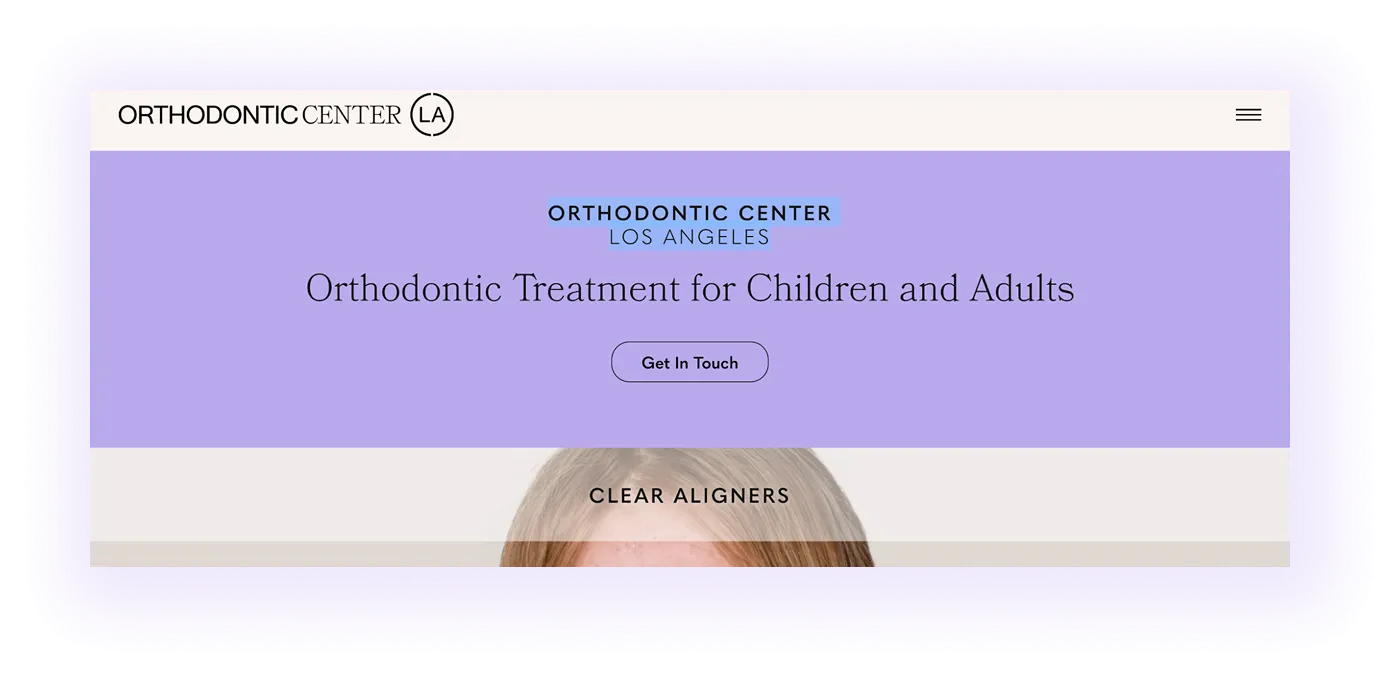
If your clinic serves multiple cities or states, your local SEO strategy should focus on dedicated location pages for each area.
For example, if you operate in Houston, Los Angeles, and New York City, create a unique page for each. Be sure to:
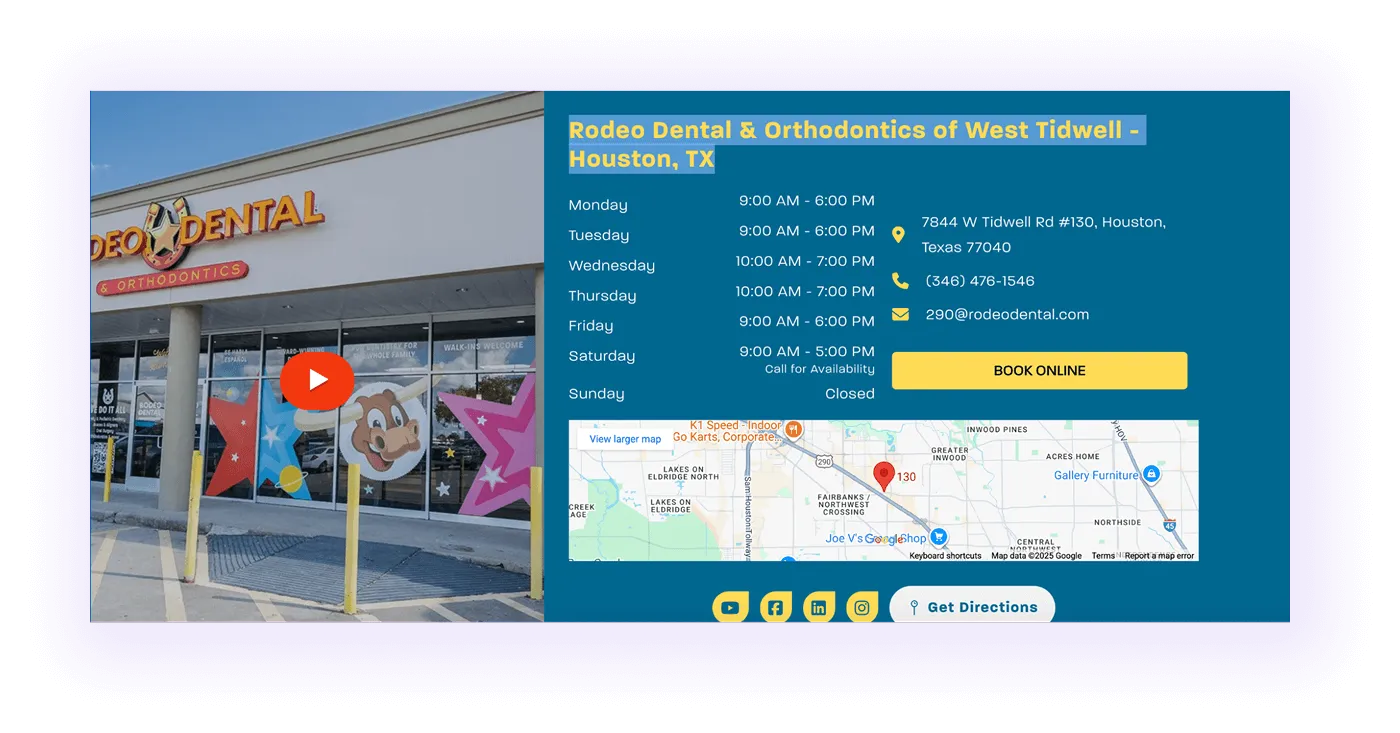
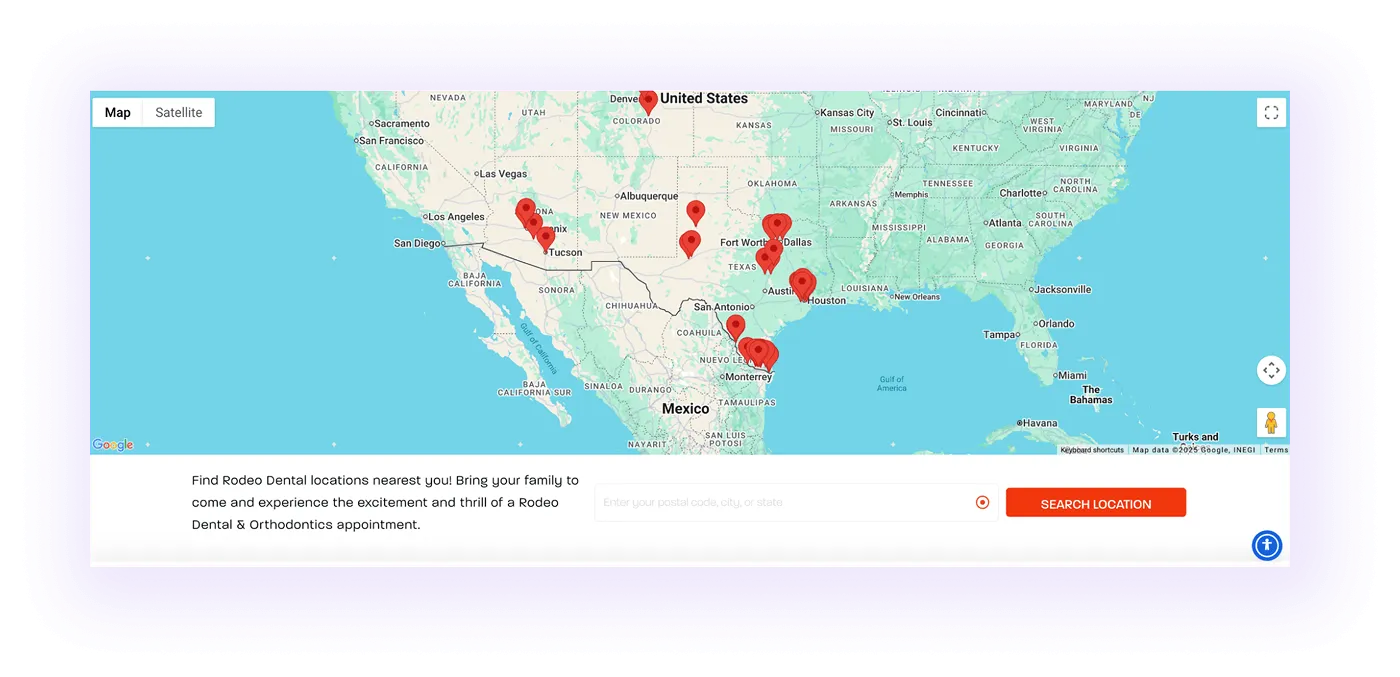

Note: Even if you offer mobile orthodontic services instead of full offices, create pages for every area you serve. This helps Google understand your coverage and ensures local patients can find your clinic online.
Over 90% of patients read reviews before choosing an orthodontist. When someone searches “orthodontist near me” or “orthodontist in texas,” Google highlights clinics with optimized Google Business Profiles (GMB) in Maps results.
To appear there, fully optimize your profile:
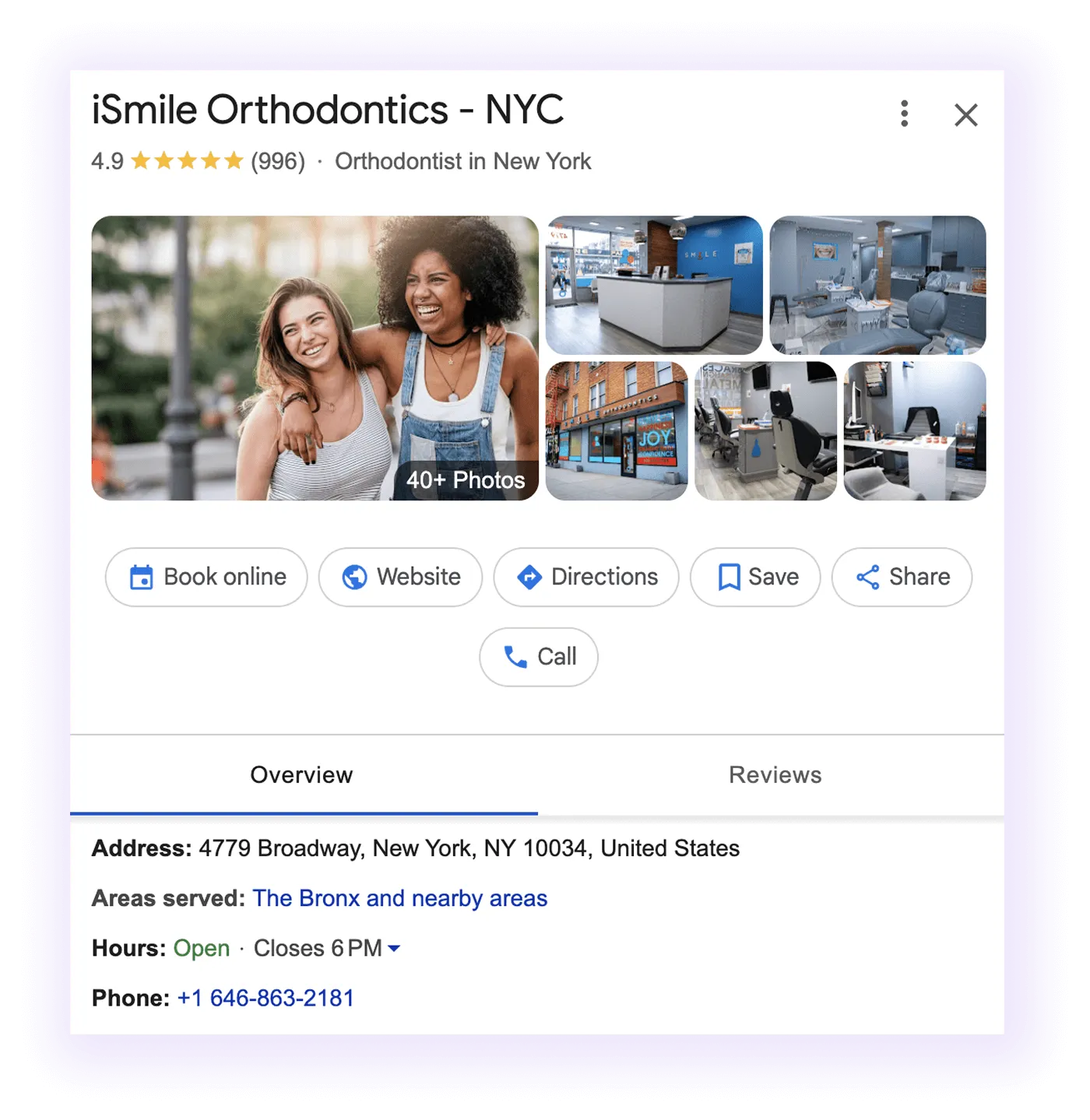
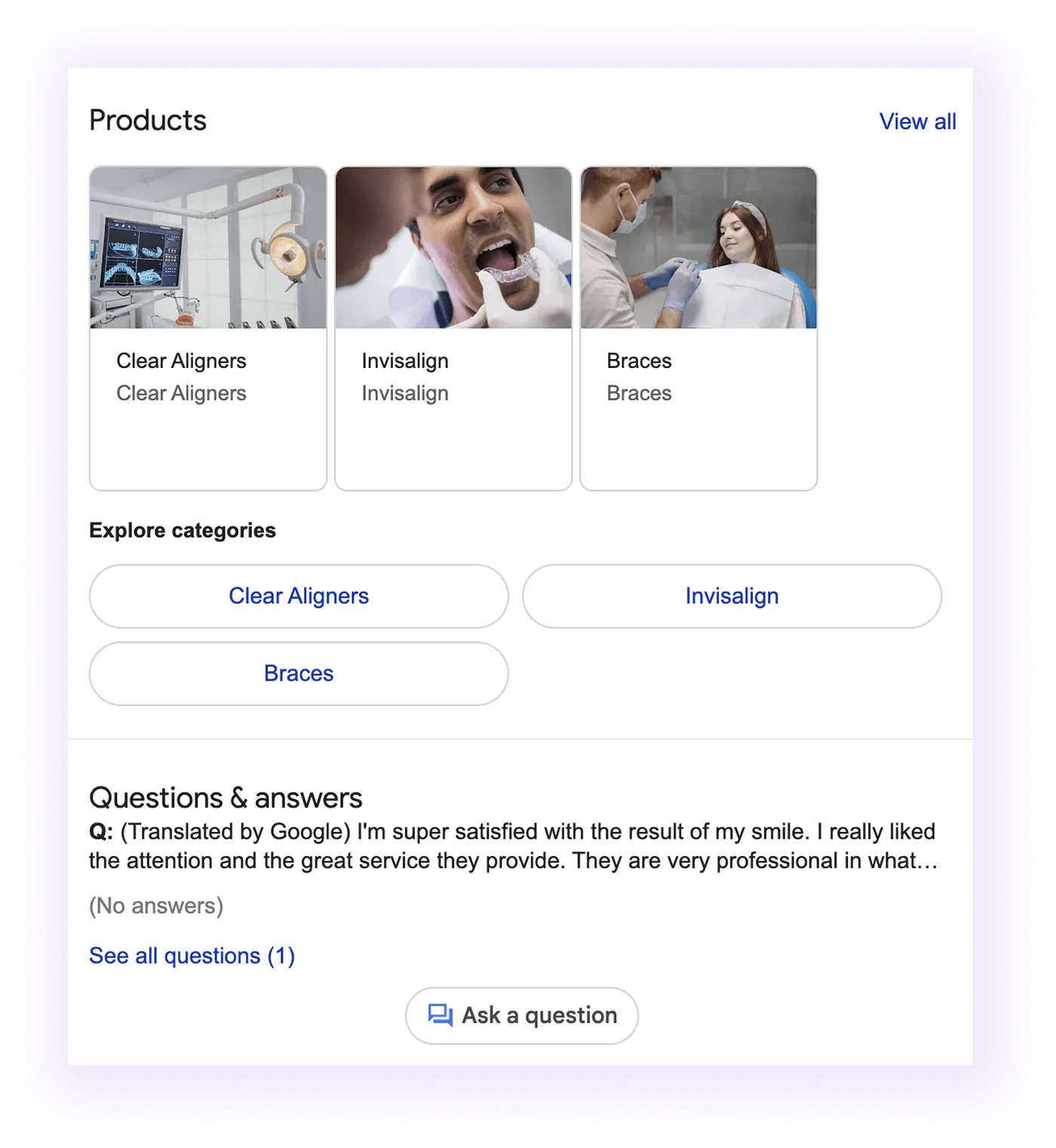
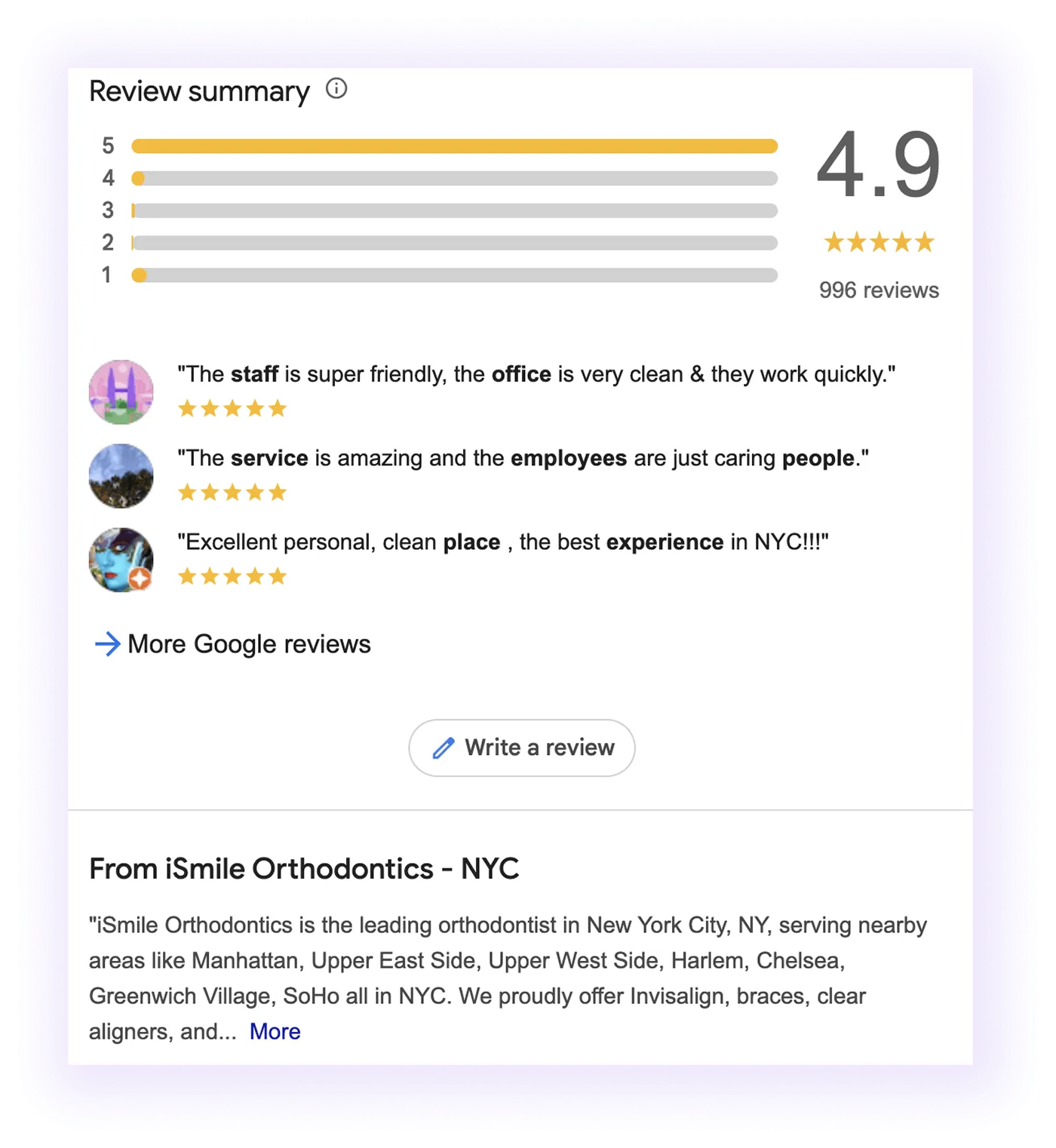
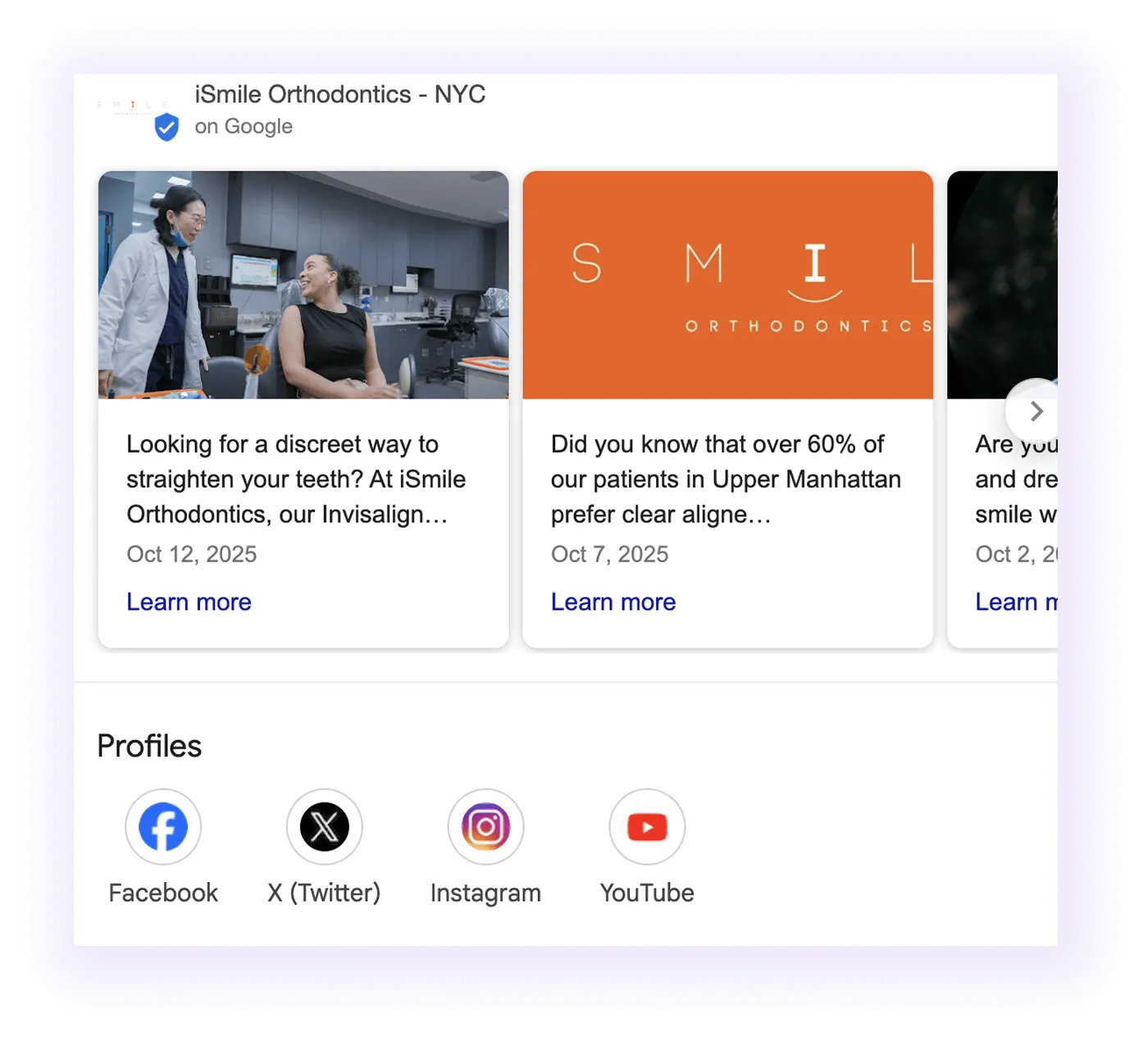
Once your GMB is fully optimized, it’ll start appearing in local searches from parents looking for nearby orthodontic care.
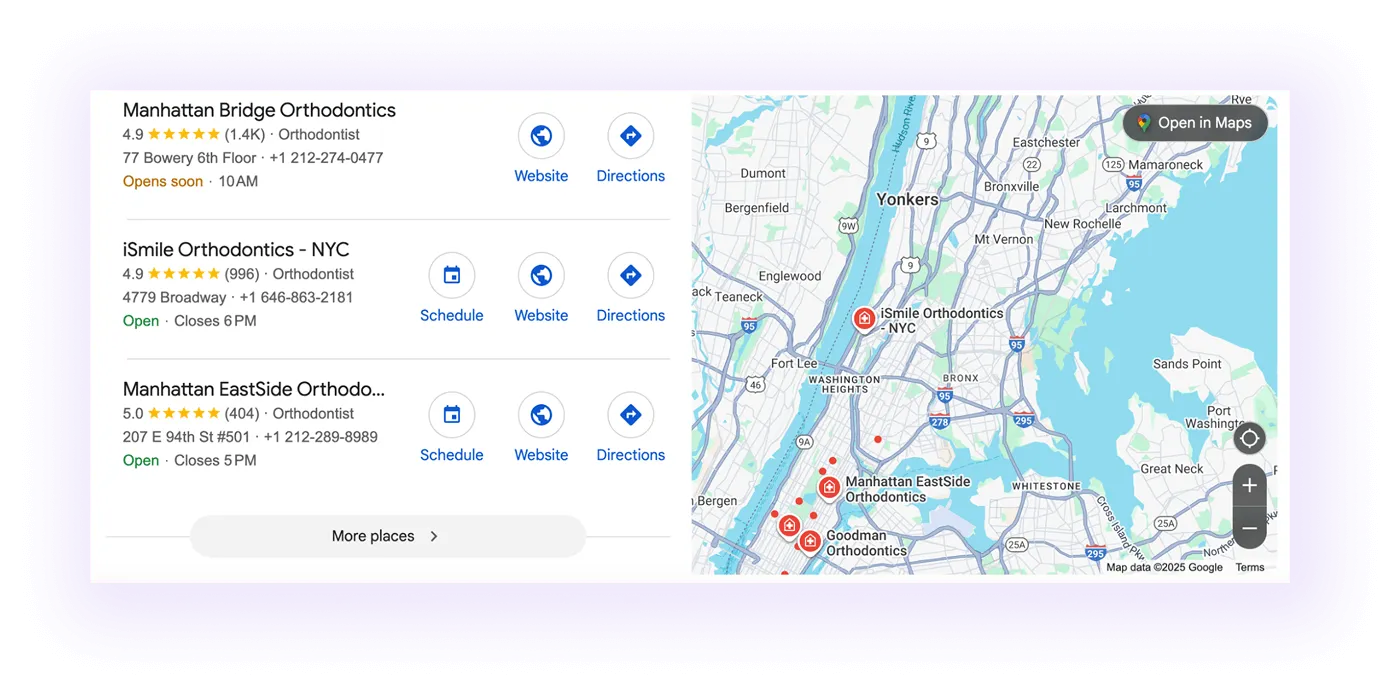
You have your core pages now, but to rank well and earn trust, your orthodontic site must meet Google’s medical content standards (YMYL), showing accuracy, credibility, and transparency.
First, you should have medical and trustworthy content. Google favors orthodontic websites with expert, fact-based information. Avoid generic copy used by competitors.
The content on your individual doctor and credentials pages should include this information:

These strengthen your site’s EEAT.
Next up, add testimonials and partnerships sections.

Feature authentic patient reviews and highlight partnerships like Invisalign or Damon Smile. Include logos from recognized organizations such as the American Association of Orthodontists.


You can add even more trust signals:


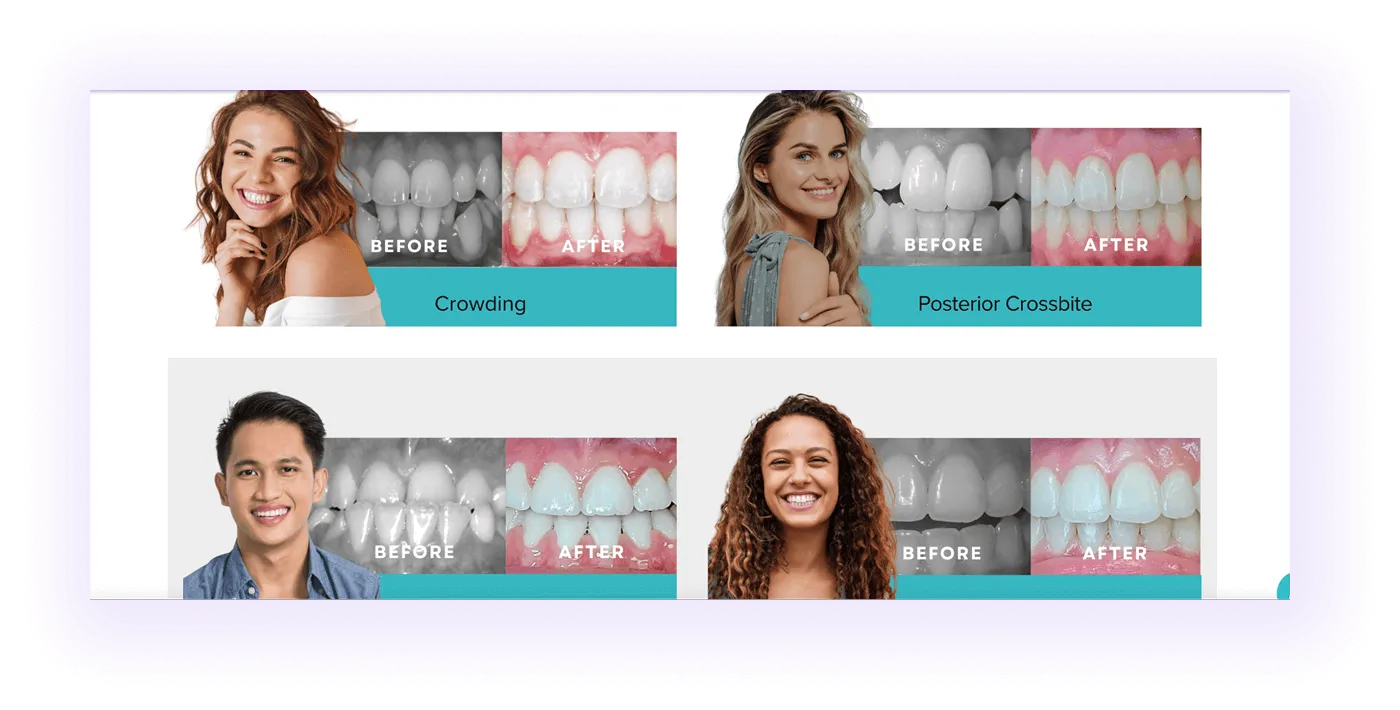
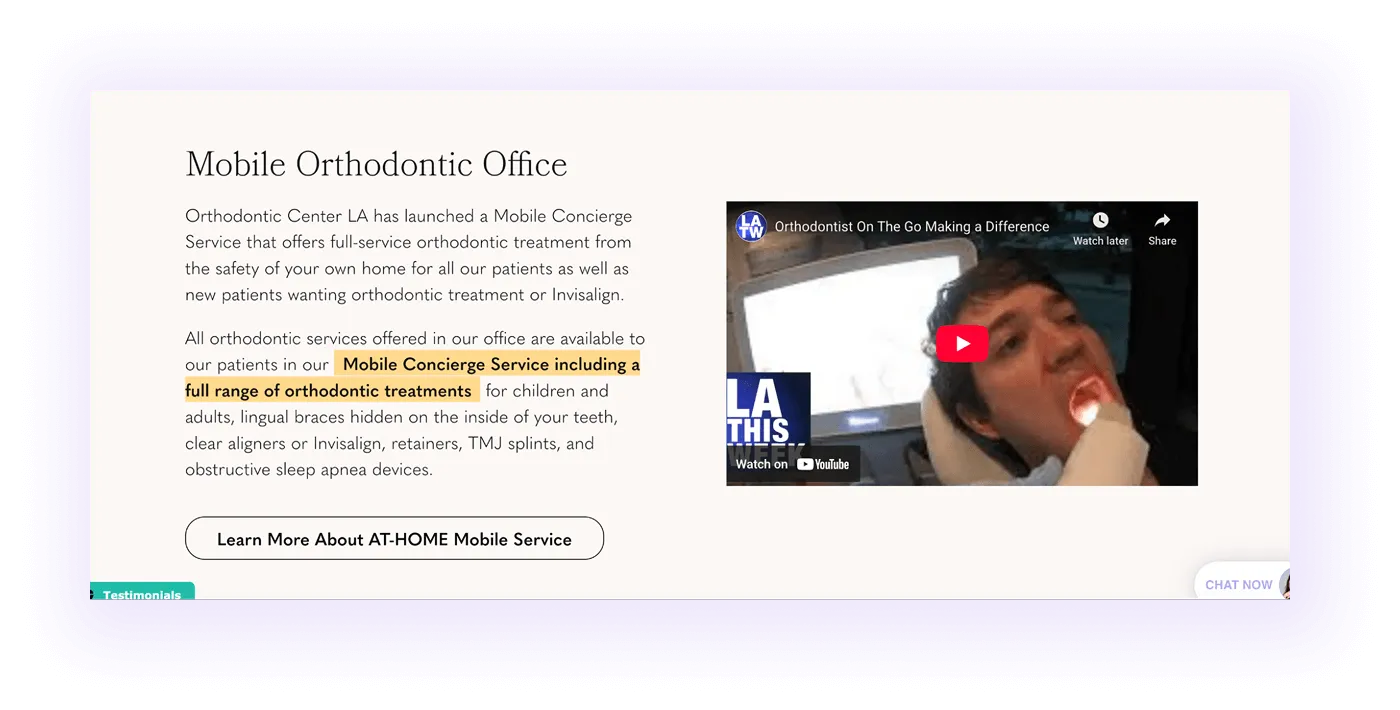
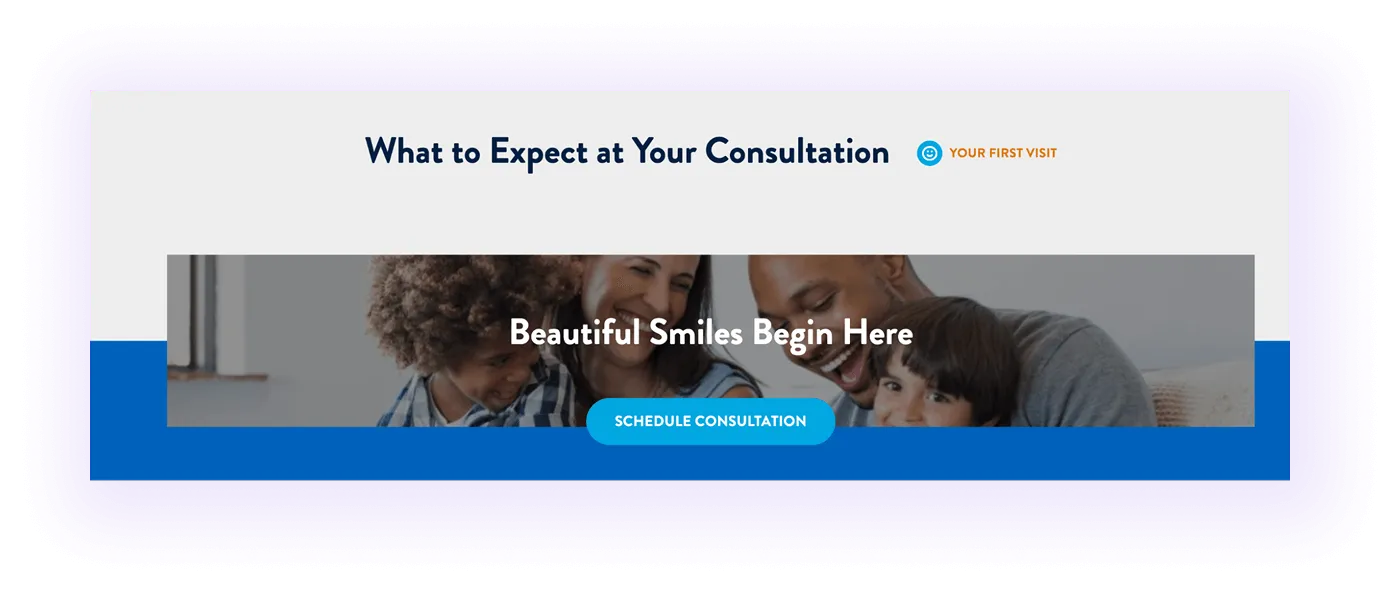
It’s really important not to exaggerate claims like “perfect smile guaranteed” or “fastest braces ever.” Instead, focus on real results and patient success stories.
You can also add pages for payment plans, careers, and insurance details to make your site more complete and trustworthy.
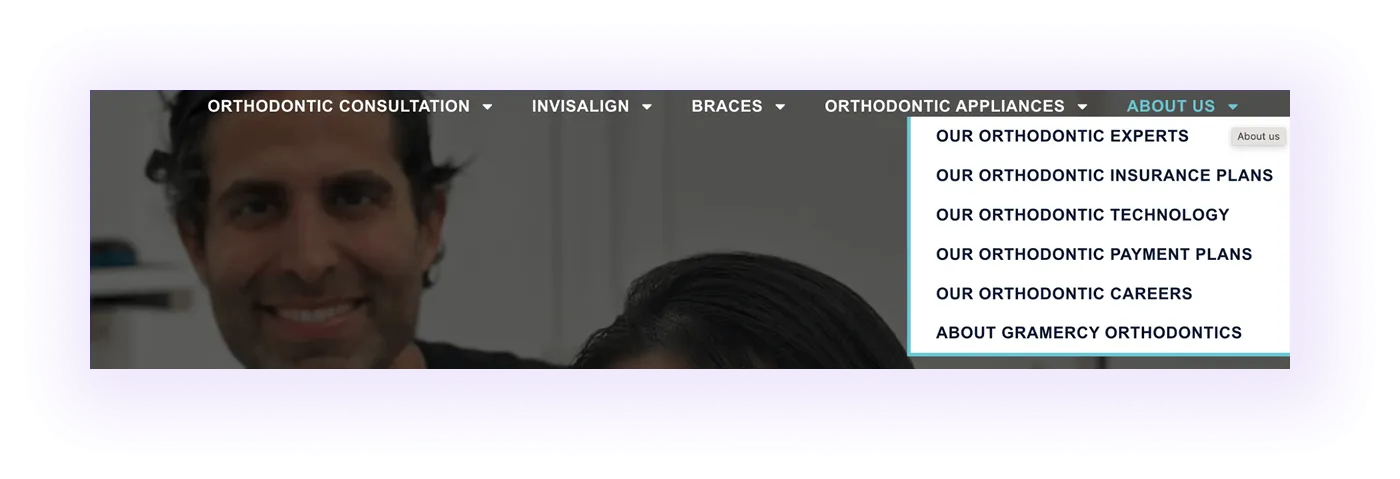
Blog content helps you reach parents and teens researching orthodontic care. Write posts that answer common questions like:
Use a pillar-cluster structure to connect these posts to your main service pages. For example:
This strategy builds topical authority and boosts rankings for your core pages.
To find blog topics, focus on what real parents ask over the phone or in consultations.
You can also use Google’s People Also Ask.

The Questions tab in Ahrefs can also give you good keyword ideas.
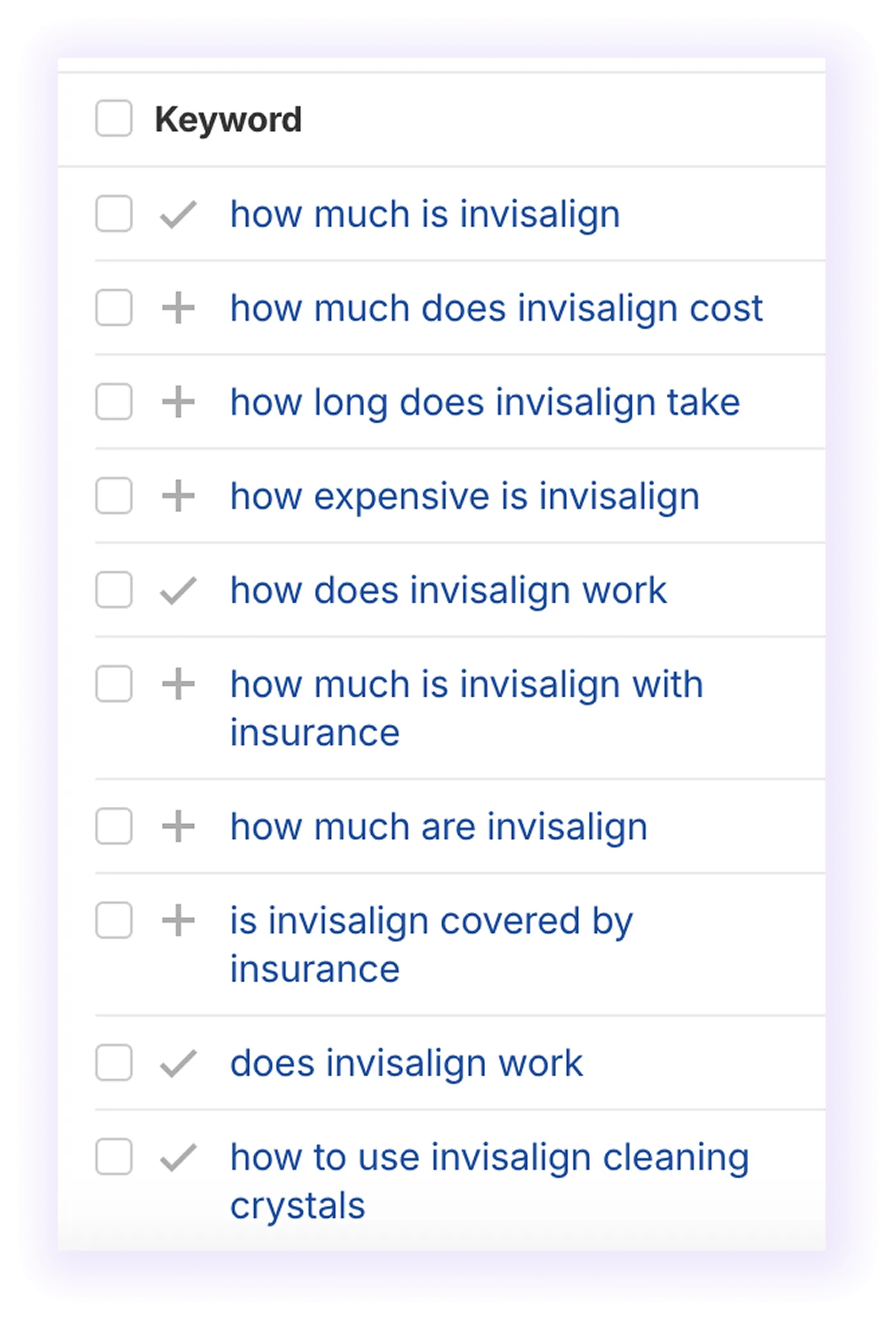
After the topics are set, use these steps to make sure your blog provides the best value:
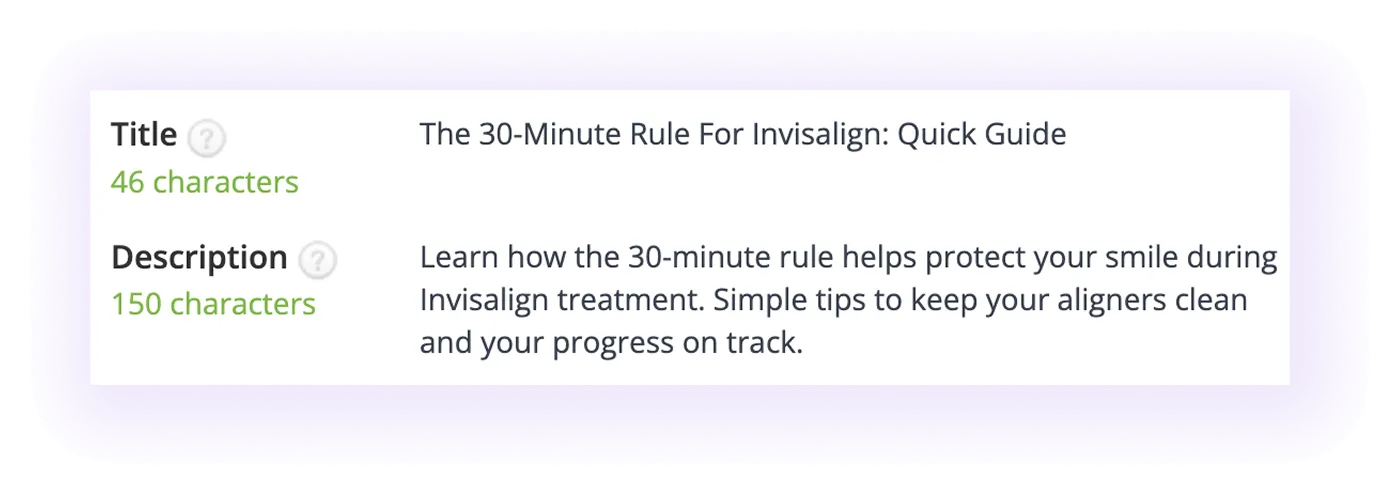
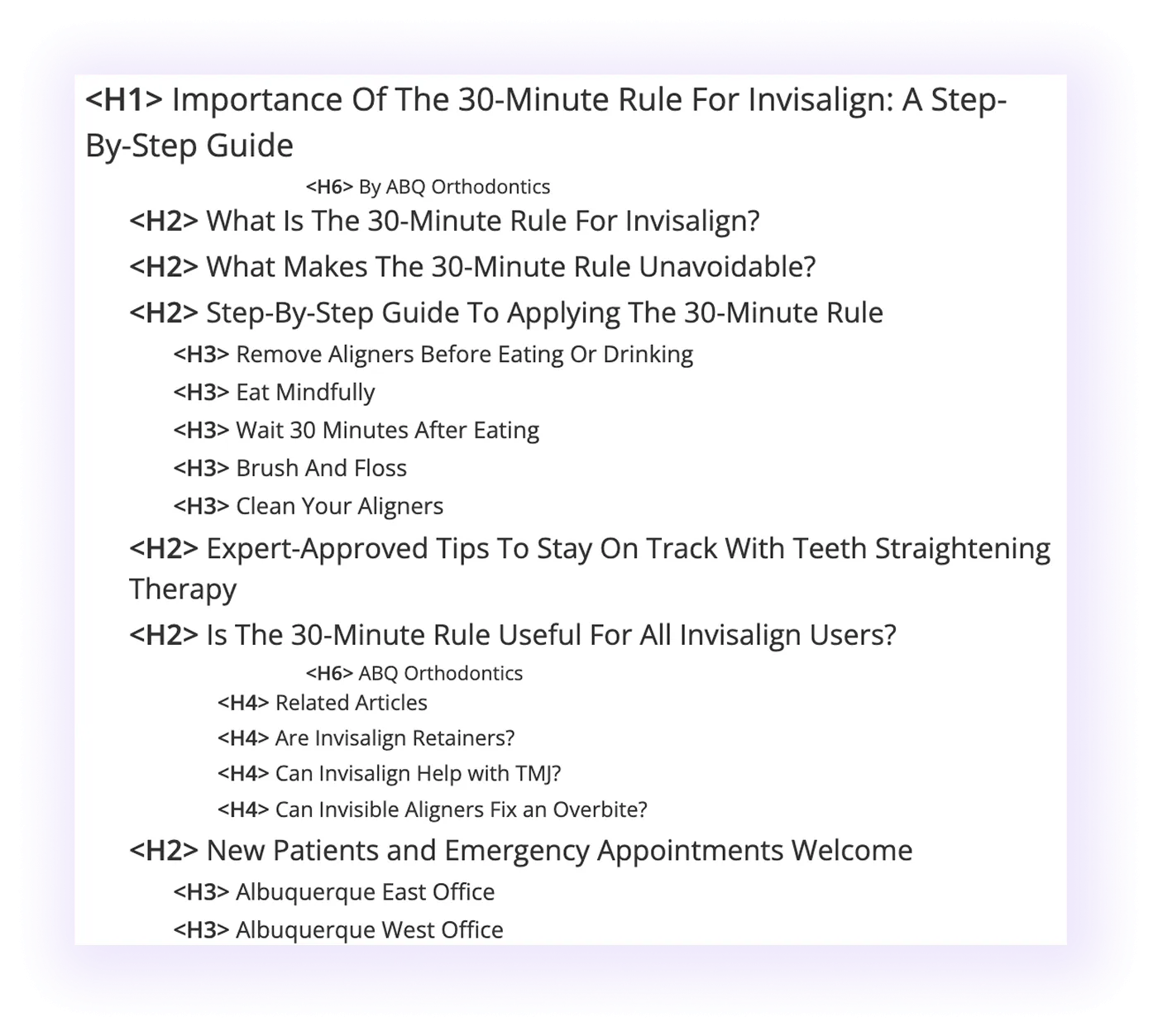
Content is in place now. Focus on technical SEO, the foundation that helps your site rank and perform well.
It covers your website’s speed, design (UI), user experience (UX), and how easily Google can crawl and index your pages.
Let’s break down how to optimize each technical element for your orthodontic site.
Start technical SEO by ensuring Google can crawl and index your orthodontic website properly. Create a clean sitemap.xml that lists your key pages with the following priorities:

If there are pages you don’t want Google to index, such as admin or test pages, make sure to disallow them in your robots.txt file.

To make your orthodontic site stand out in Google search results with reviews, FAQs, or featured services, add structured data, also known as schema markup.

Recommended schema types for orthodontists include:
Keep your URLs simple, readable, and optimized for both users and Google.
Do’s:
Don’ts:
Examples:
Using clean, descriptive URLs improves both orthodontic SEO and user experience.
Internal links help build topical authority, share ranking power between pages, and guide visitors through your site.
Use a mix of link types to connect related content. Here’s a quick overview of how and why to use them:
See an example of internal linking below:
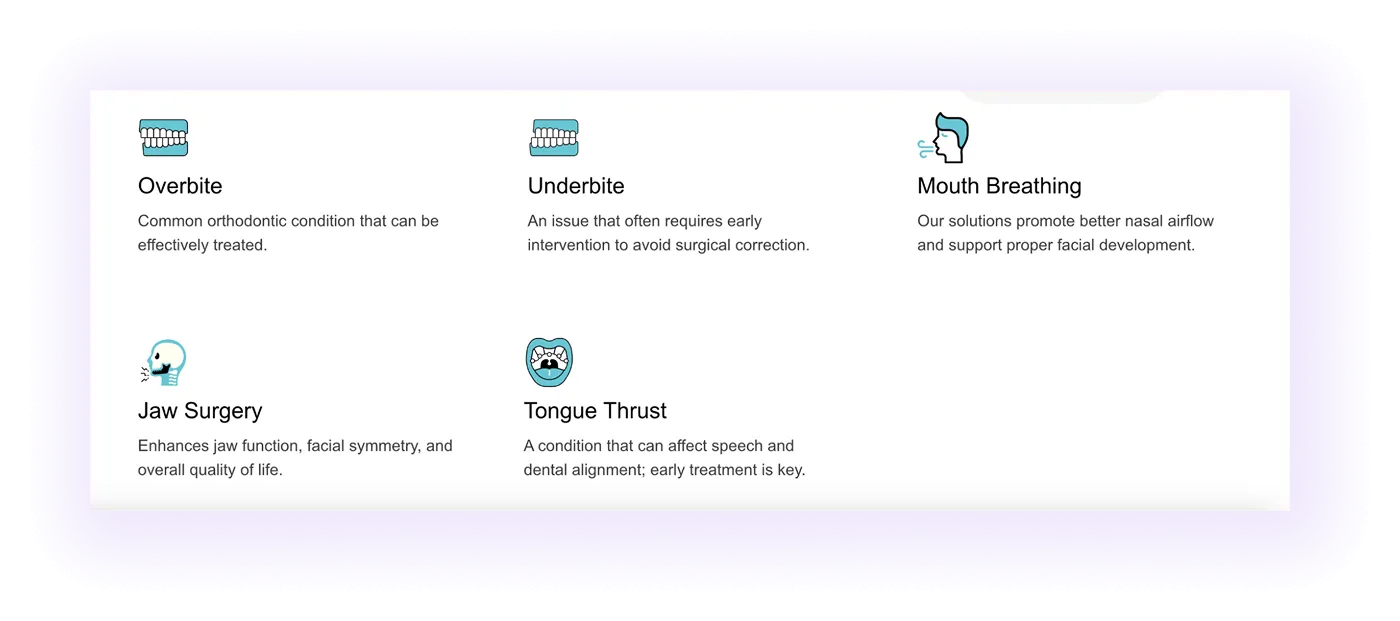
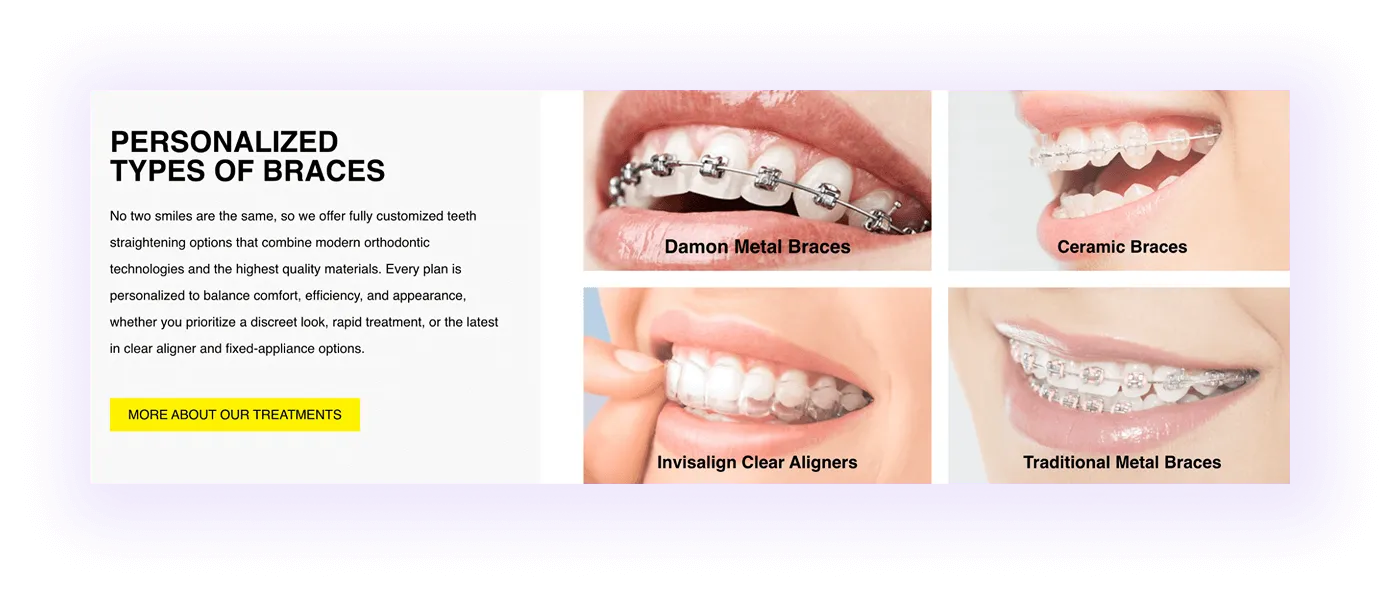
Most patients search for orthodontists on their phones and often book directly from there. A fast, responsive site not only improves user experience but also boosts SEO rankings.
To ensure a great mobile experience:
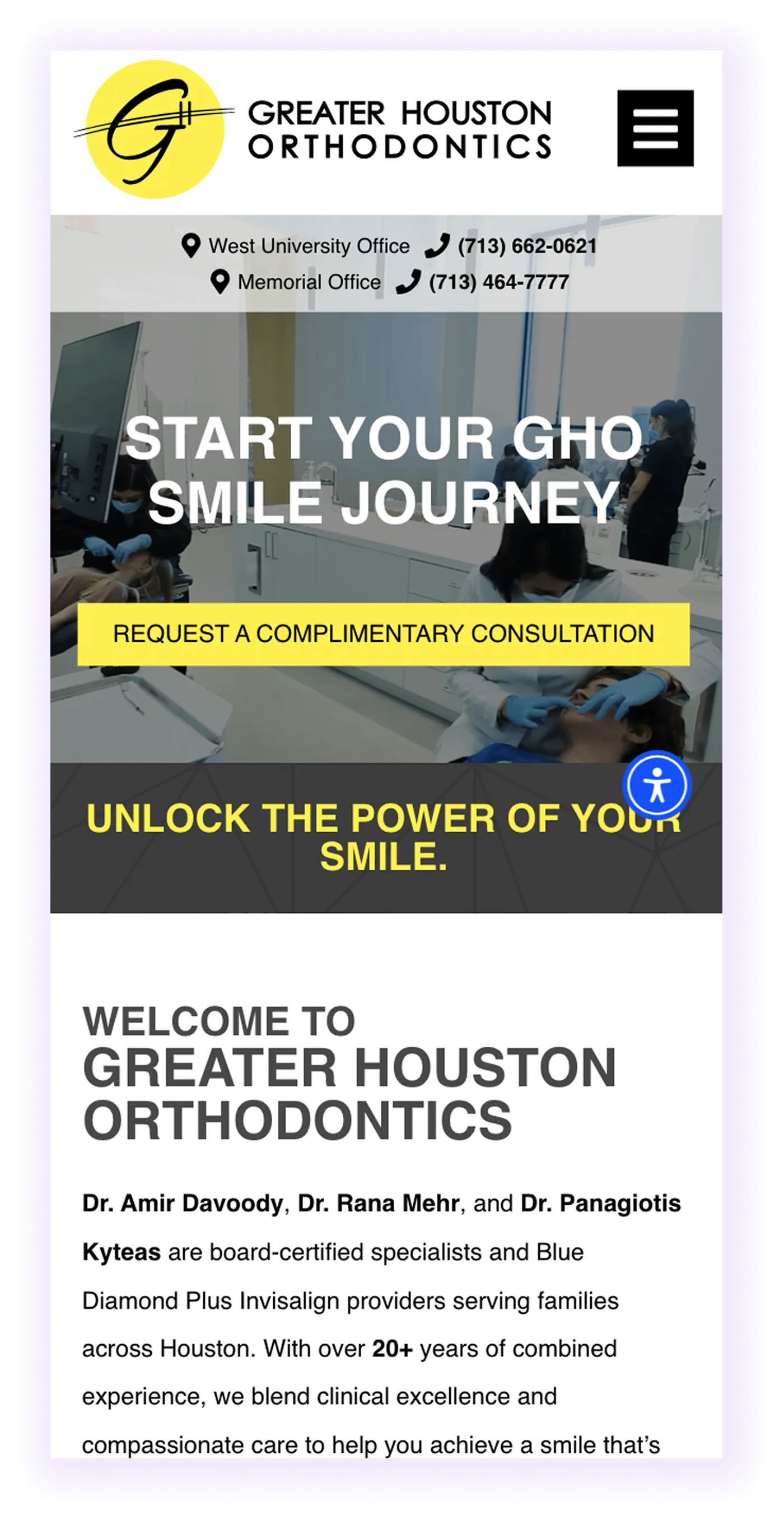
Patients searching for orthodontic care expect your site to load fast, and so does Google. Speed directly affects both user experience and rankings.
To improve your website performance:
After optimizing, test your site with Google PageSpeed Insights or GTmetrix and monitor these Core Web Vitals:

Passing Google’s Core Web Vitals ensures a faster, smoother experience for patients and better SEO performance.

With every change, such as adding new services (like “teeth whitening”) or expanding to new locations, technical issues can arise.
Run a monthly technical audit to maintain strong performance and SEO. Check for:
Regular audits help maintain site health, protect rankings, and ensure parents and patients always have a smooth browsing experience.
If you’d rather leave the technical work to experts, our orthodontic SEO agency can perform a technical audit and provide a detailed action plan with ongoing support to keep your site fully optimized.
A strong website structure and EEAT content build trust, but without authority, your orthodontic site won’t rank competitively.
To earn that authority, develop a link-building strategy focused on high-quality backlinks from trusted dental and orthodontic sites that reference your clinic.
Here are the most effective ways to build those links.
To start building authority, focus on earning links from relevant, high-quality sites in related niches, such as:
Two proven strategies work best:
When reaching out, highlight the value you bring (updated insights, clinical expertise, or data that improves their article), so editors see your contribution as genuinely helpful.
Parents often check more than just Google Maps. They browse online directories to compare and verify orthodontic clinics. Listing your practice on reputable platforms boosts both visibility and credibility.
These are the recommended directories for orthodontists:
When creating profiles, include:
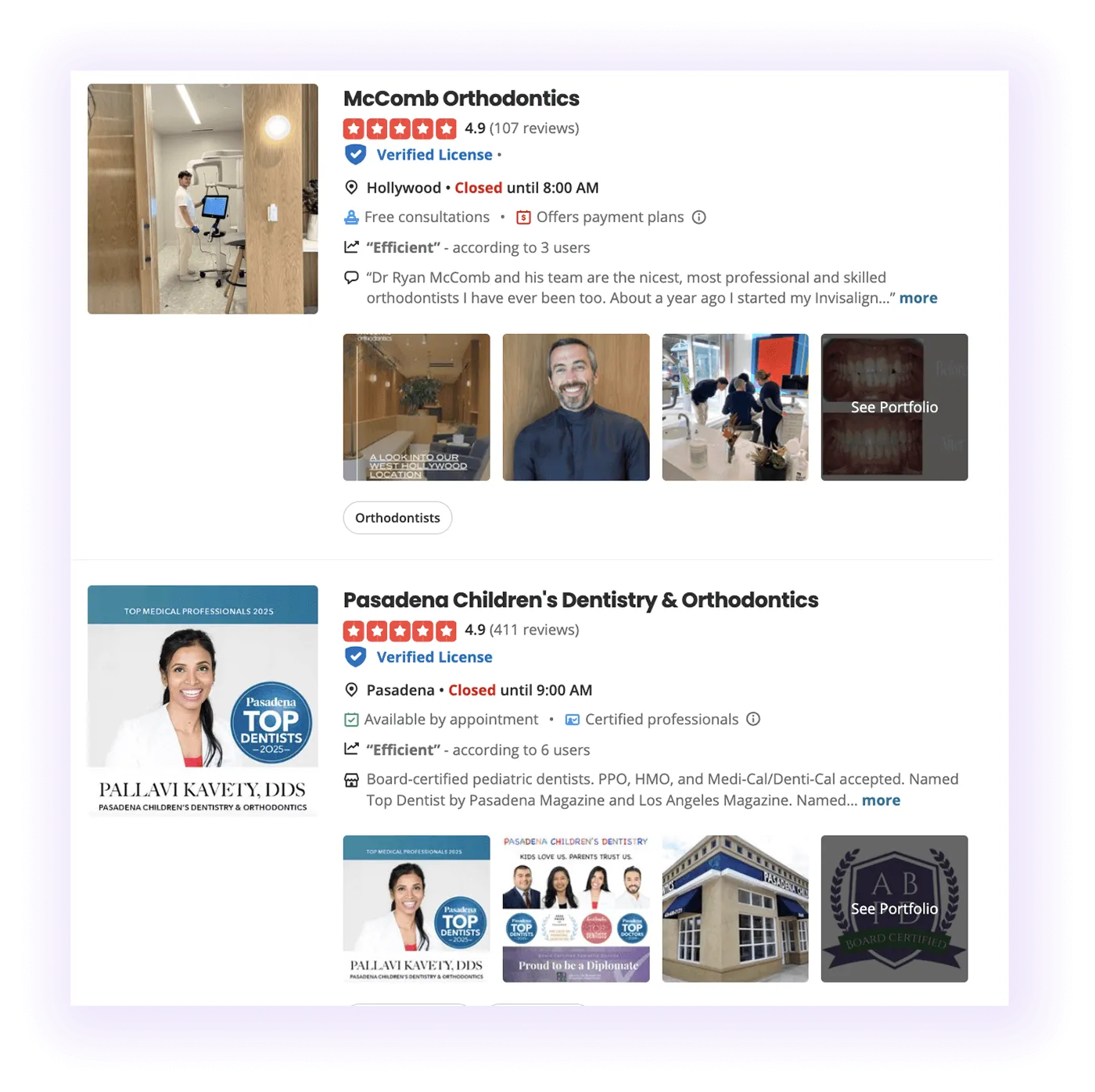
Use digital PR to earn backlinks and mentions from trusted outlets like Forbes and dental journals like AJODO.
This is how to run a successful digital PR campaign:
Once your orthodontic SEO is live, use the right tools to track the metrics that drive patients to your clinic.
Regular tracking helps you fine-tune your orthodontic SEO and focus on what brings real patients through the door.
There’s no shortage of orthodontist options out there, but you can make sure your practice stands out.
With the right orthodontic SEO strategies, we’ll help your services get noticed by more local patients. Contact us, and let’s work together to improve your visibility and drive more patient traffic to your website.
Submit the form - Get Free Proposal
%202.png)
24 hours